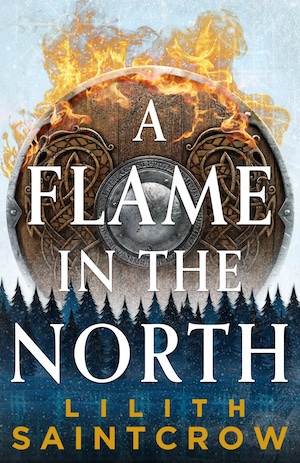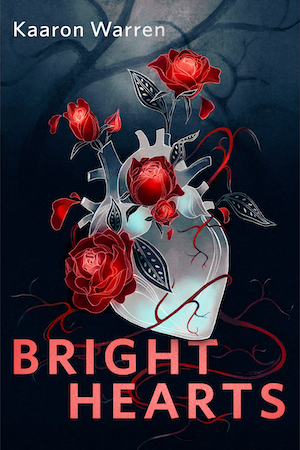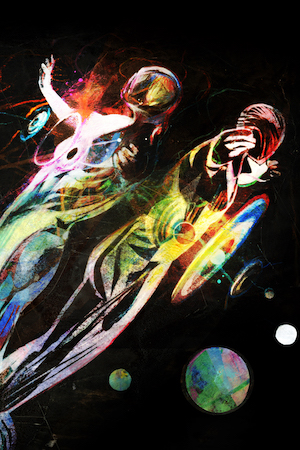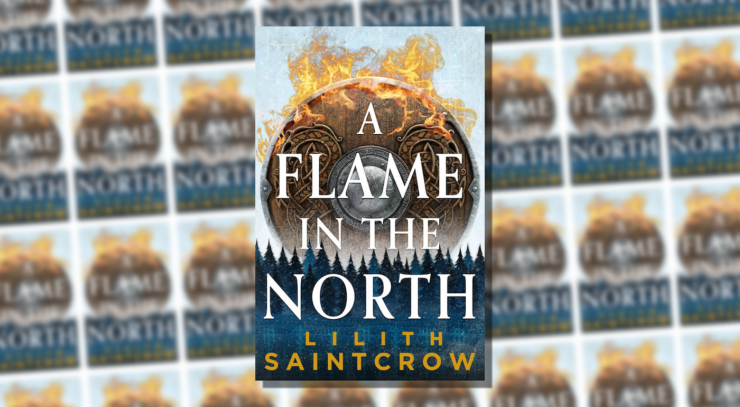A Flame in the North is the latest novel by Lilith Saintcrow, and marks a departure from many of her recent efforts. This is a fantasy novel in a classic mode, reminiscent of J.R.R. Tolkien and Robert Jordan in its form as much as its matter: one great big chunk of an even larger epic (in this case a trilogy), where the last page marks a cliff-hanging caesura rather than a conclusion.
It’s always difficult to review a story that has not yet formed a complete narrative arc: You can say much about what it promises and what it does so far, but assessing its successes must usually hinge upon seeing the whole thing. In the case of A Flame in the North, Saintcrow has complicated my task even further in the extent to which her worldbuilding and her protagonist’s journey recollects—elegantly, deliberately, intentionally (as when in music one instrument elaborates a variation on another’s theme), and above all closely—one of the ur-texts of the fantasy genre. The extent of Saintcrow’s echoing of Tolkien’s mythopoesis drives me to caution. Shall it turn out to be earnest imitation, clever commentary, subtle subversion, or some other thing?
I have hopes it will prove clever, since for all my uncertainty about where it’s going next, A Flame in the North provided a wildly entertaining epic journey.
But let’s come back to this. A Flame in the North begins with Solveig, daughter of Gwendelint. It’s the eve of a festival, and Sol is to play a significant role in the night’s ritual, lighting and tending the midwinter flame with the power of seidhr for the very first time: proof of her ability as a fully trained volva. Her sworn companion is the shieldmaiden Arneior (“Arn”), three years her elder and pledged to her protection and support. The domestic intensity of Sol’s life—father a local chief, mother ill with a winter sickness, an elder brother who means well but is a source of trouble, a younger sister for whom she feels responsible, the bustle of a household preparing for a great celebration when everything needs to run smoothly—combined with the first-person narration gives us a great sense of intimacy in this skillfully-drawn, strongly Norse-inflected world, whose concerns lie as much with feeding and clothing a household as with the rites that encourage the sun to rise again on the year’s longest night.
But Sol returns home from the work of ritual to learn that her brother has slain a man, a Northerner of high birth, and that she is to be the weregild to make good the blood debt: to go north with the dead man’s brother, Eol, and his companions for a year and a day and do all that is honourable in his service. She will at least have Arn with her for her defence, but the journey she finds herself on is stranger and more perilous than she ever expected. Aeredh, one of Eol’s companions, is one of the Elders (immortals with pointy ears) thought to have departed the lands after the defeat of the great Enemy in the Black Land, centuries past, while Eol and the others have inherited a curse from the Enemy that causes them to shift their forms between beasts and men.
That Enemy is awake and moving once more, and according to Aeredh—once she finally pries some straightforward answers out of him—Solveig’s particular affinities with seidhr (she can call fire) are a) incredibly rare, and b) potentially key to successfully opposing the Enemy. Solveig is not exactly thrilled to suddenly find herself with far more epic-scale problems than she’d ever expected, especially in the company of men who’ve been quietly misleading her—or at best, neglecting to mention certain important truths—since the moment they first met. But by the time she understands what kind of saga she’s stepped into, it’s far too late to turn back, even if she was willing to take the risk that Aeredh and Eol were wrong about her ability to affect the outcome of the great struggle against the Enemy.
Buy the Book


A Flame in the North
Saintcrow writes with compelling vigour and atmosphere, and a vivid, measured first person voice. Sol’s character engages from the first page, as does Arn’s; their familiar friendship and deep (nonsexual) partnership is a strong thread in the story’s weave, and one I very much enjoy. The landscape of Sol’s journey feels palpable, material; the tension and peril mounts even in moments of rest.
But holy shit, the extent of the Tolkien homage. If you’ve read the Silmarillion in the distant past, you may feel a certain familiarity: closer acquaintance with Tolkien’s legendarium make the direct parallels inescapably clear. The Enemy has been besieged in the Black Land. Among his servants are creatures called urukhar and belroch, and seven captains who are the most terrifying of his servants. The chapter epigraphs hint at some Beren and Lúthien and Húrin shenanigans, while the text itself gives us clear echoes of the Silmarils, Fëanor, his sons, and the oath that led to so much suffering in the First Age; Túrin and Glaurung; Doriath and Thingol; the city of Nargothrond and its fall; and the hidden valley of Gondolin. Among other, perhaps less obvious, echoes. I’m not a Tolkien completist, but this feels like a tour through the end of Tolkien’s First Age—lightly disguised, and viewed from a different angle.
(Arachnophobes beware, for there are also Mirkwood spider-esque shenanigans.)
Tolkien’s legendarium is the great mythopoetic work of the 20th century. It’s fascinating to watch Saintcrow engage with it directly through a fictive lens. And as it grew from its inventor’s scholarship in Old English (and Old Norse) literature, it feels natural that Saintcrow should bring even more Norse mythic elements to this deep engagement.
But. (There’s always a but.) I have some difficulty summing up, here, for Saintcrow is so clearly, so plainly, so purposefully doing something with the Matter of Middle Earth. But it is not yet clear whether the intent is to recapitulate, rebuke, or reinterpret entirely. A Flame in the North is one part of an unfinished story. I’m engaged by it, and invested in it: I want to see where it’s headed next.
But I won’t know what I really think of it until it’s all the way done.
A Flame in the North is published by Orbit.










